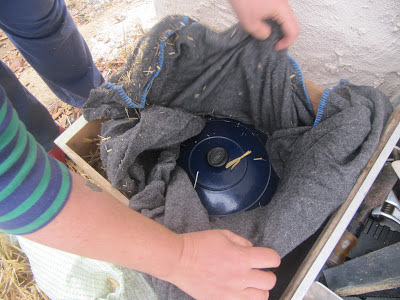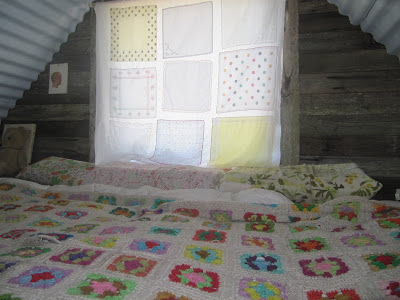For a blog writer, I guess I don't really read heaps and heaps of blogs myself. There are those - like Whole Larder Love, Milkwood, the Forager's Year, and the Witch's Kitchen - which I read every day. Then there are my friends' blogs - like Feather and Nest and Happy Earth - which I read every now and then to see what's happening in their world. Then there are others which I like to save up for times when I need an extra-special injection of inspiration, or for when I'm feeling a bit down in the dumps and need a boost - a reminder that there are beautiful and wonderful things being created in the world by exceptionally talented people. While She Naps and Fog and Swell fall into this category, and I think the reason that I find them both so extra-special is because they're both crafters who work in three dimensions. Yes, I know - clothes are (hopefully) three-dimensional, so technically I also craft this way - but there is just something totally awe-inspiring about what these 2 ladies do, especially when they work together.
 |
| A totally amazing and beautiful crab, borne of 2 clever ladies craftily inspiring one another |
Makes me want to embark upon a collaborative craft project with someone!!!
One day recently while I was having a particularly crappy day at work, I lunched at my desk just so I could have a little pick-me-up fix from my favourite 2 pick-me-up blogs, and I stumbled upon a pattern on While She Naps for a topsy turvy doll. I'd never seen one before, and thought it was super-cute and maybe a good project for the kids for christmas, so I bought the pattern. Abby, the maker of the pattern, was super nice and helpful!
I've never really made any softies before, other than a stuffed rocket-ship, the odd owl-shaped cushion and occasional sock bunny which, let's face it, isn't exactly super-challenging. I suppose I was intimidated by all the small bits, all the turning inside out and stuffing and embroidering of features. And I was scared of the third dimension. But Abby's pattern was extremely well-written and well-photographed, so I felt OK. It felt like something I should be able to do, and I was up for the challenge. I even thought I was capable of altering the pattern so that the dolls were animals, rather than girls, seeing as our little kids are so very in love with all creatures great and small. I did simplify things a bit - obviously, I made them have ears instead of hair (the animals - pig, lion, cat and bunny - were decided on because I thought these were all animals I could characterise just by making different ears and facial features, so I could still use Abby's basic head shape), and I left off the opposable thumbs in preference for 'paws'. I also didn't stuff the arms because I just could not get my head around how to stuff those teeny tiny arms. It was Christmas eve, after all...
 |
| Lion and cat cavorting in the artichokes... |
 |
| Become bunny and pig (yes - the pig has a 3 little pigs print frock on. Couldn't help myself) |
It was an interesting challenge for me. Working on something like this forces you to focus on the detail, and following a pattern for something you're unfamiliar with (something I am very unaccustomed to) forces you to take it slow, step by step, and think about what you're doing in a careful way. Anyone who knows me will know that none of these things come easily to me. But sometimes it's nice to do things that don't come easy. And it's rewarding too.
And when our bubbas woke up on Christmas morning and climbed down the ladder out of their brand-new sleeping loft, it was extra-lovely to see their little faces as they happily topsy-turvied their lion/pig and bunny/cat. I even feel like I could do it again!
So thanks Abby, for writing a pattern that was challenging for my dimension-phobic self, but ultimately not too traumatic, and thanks for inspiring me with your blog.
And thanks kiddies for loving your dolls, and asking for them as you're falling asleep. It makes it all worthwhile.
 |
| Oski, loving his lion and Olive's rocket ship |
































